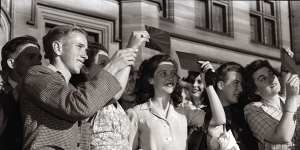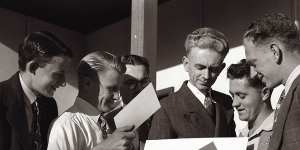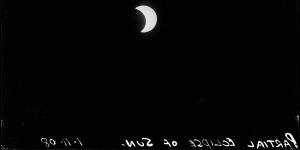ECLIPSE
Only Slight Dimming
Few Sydney people took any interest in the partial eclipse of the sun by the moon yesterday afternoon.
Conditions were ideal for observing the eclipse as the western sky was practically cloudless at the time.
Most people who were asked said they had forgotten about it,and had not noticed anything peculiar about the sunlight.

Eclipse of the Sun,looking through film and looking through cardboard,City,1 November 1948Norman Brown
When the eclipse was at its maximum at 5.45 p.m.,with the moon covering about two-thirds of the sun,the light became slightly dimmer,but not dim enough to attract attention.
The light became slightly brighter towards sunset,which occurred at 6.22 p.m.,before the end of the eclipse.
The Three Sydney scientists of the C.S.I.R. who set up a base at Strahan,on the Tasmanian west coast,were unlucky,as they caught no glimpse of the sun until about 6 p.m.
Only fleeting glimpses of the eclipse were seen in Melbourne.
At 4.39 p.m.,when the first phase began,it was raining and the sun showed through the clouds only briefly four or five times.
In Sydney a few birds,mainly starlings,were misled by the premature dullness and returned from their feeding-grounds to their nests in Hyde Park and the Botanic Gardens before 6 o’clock.
Poultry farmers,however,said that the eclipse had not deceived their fowls,who went to their roosts at the normal time.

Eclipse of the Sun,looking through film and looking through cardboard,City,1 November 1948Norman Brown
QUICK GLANCES
Most people who watched the eclipse heeded the warnings of eye specialists on the danger of looking at it directly.
A few people said they had risked taking a quick glance at the sun.
No cases of eyes being damaged by the eclipse were reported by ambulance officers or hospitals last night.
A leading Macquarie Street eye specialist said that persons who had damaged their eyes by looking at the eclipse would be aware of the damage immediately.
They would have a blank space in the centre of their vision,corresponding to where the rays of the sun had burnt and permanently destroyed part of the sensitive retina at the back of the eyes.
Hundreds of such cases were reported after the last eclipse visible in Sydney in 1943.
EXPERIMENTS

A view of the partial eclipse.Staff
All radio experiments associated with the eclipse were successful,Dr.J. H. Piddington,of the Radio physics Division of the C.S.I.R.,said in Sydney last night.
One of the objects of the experiments,he said,was to find out whether there was a magnetic field around the sun as there was around the earth.
It would be several weeks before the results of the experiments would be known.
The N.S.W. Government Astronomer,Mr. Harley Wood,took a photographic record of the eclipse from the Observatory.
Mr. Wood said that the photographs were mainly for purposes of record as a partial eclipse was not of much interest to astronomers.
It was only during a total eclipse that they could observe the sun’s corona,which is of most interest to astronomers.
The last total eclipse visible from Sydney was in 1857.